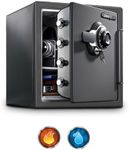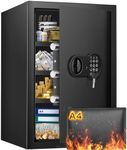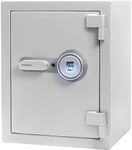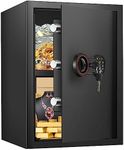Buying Guide for the Best Fireproof Safes
Choosing a fireproof safe is an important decision if you want to protect valuable documents, cash, jewelry, or digital media from fire damage. The right safe will give you peace of mind, knowing your most important items are secure even in the event of a fire. When shopping for a fireproof safe, it's essential to understand the key features and specifications that determine how well the safe will protect your belongings. By learning about these specs, you can match your needs to the right safe and make a confident purchase.Fire Rating (Duration and Temperature)The fire rating of a safe tells you how long it can protect its contents from fire and at what temperature. This is usually measured in minutes or hours, such as 30 minutes, 1 hour, or 2 hours, and the maximum temperature it can withstand, often around 1,400 to 1,700 degrees Fahrenheit. A higher rating means better protection. If you live in an area prone to fires or want to store highly sensitive items, look for a safe with a longer fire rating. For basic home use, a 30-minute to 1-hour rating may be enough, but for important documents or irreplaceable items, consider a safe with a higher rating.
Size and CapacityThe size and capacity of a fireproof safe determine how much you can store inside. Safes come in a range of sizes, from small boxes for a few documents to large cabinets for multiple binders, electronics, or valuables. Think about what you need to protect now and in the future. If you only have a few passports and some cash, a compact safe will do. If you plan to store more items or larger objects, choose a bigger safe. Make sure to check the internal dimensions, as the fireproof insulation can make the inside smaller than the outside.
Locking MechanismThe locking mechanism is how you open and secure the safe. Common types include key locks, combination dials, digital keypads, and biometric (fingerprint) locks. Key locks are simple but can be lost, while combination and digital locks offer more convenience and security. Biometric locks are quick and easy but may require batteries. Choose a locking mechanism that matches your comfort level and how often you need to access the safe. If you want quick access, digital or biometric may be best; for traditional security, a combination or key lock works well.
Water ResistanceSome fireproof safes also offer water resistance, protecting your valuables from water damage due to firefighting efforts or floods. This is usually indicated by a water resistance rating, such as how long the safe can be submerged or how much water it can withstand. If you live in an area prone to flooding or want extra protection, look for a safe with a water resistance feature. If fire is your only concern, this may be less important.
Weight and PortabilityThe weight of a fireproof safe affects how easy it is to move and how secure it is from theft. Heavier safes are harder to steal but more difficult to relocate. Lighter safes are easier to move but may need to be bolted down for security. Consider where you plan to keep the safe and whether you might need to move it in the future. If theft is a concern, a heavier or mountable safe is a better choice.
CertificationLook for safes that have been tested and certified by recognized organizations, such as UL (Underwriters Laboratories) or ETL. These certifications mean the safe has passed specific fire and security tests. Certification gives you confidence that the safe will perform as promised. Always check for certification if you want reliable protection.















